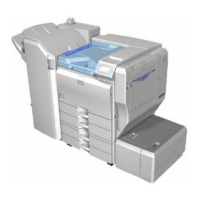Development
SM 6-29 G179
Detailed
Descriptions
conditions below continue to exist.
Vsp ≥ 2.0
Toner end counter ≥ 90 when SP2213-001 is set to "0".
Toner end counter < 90 and Vt (10) > (Vref + 0.3) when SP2213-001 is set to "0".
When SP2213-001 is set to "2"
Vsp ≥ 0.9 when SP2213-001 is set to "2"
Special order
6.7.7 TONER END RECOVERY
If the front door is opened for 10 seconds and then closed while a toner near end/end
condition exists, the machine will attempt to recover. When the front door is closed, the
toner supply motor turns on to supply toner. The machine checks the TD sensor output 2
seconds after the main motor turns on (Vtp), and the sensor is checked again every 1
second (Vtp1)
The machine detects the toner concentration using Vref, Vt (10), Vtp, and Vtp1. If the toner
concentration is still too low, the toner supply motor remains on for another 10 seconds
while the machine checks Vt. If toner concentration is judged to be at the standard level,
then the toner near end/end condition is cancelled and K (toner supply coefficient) is reset.
If toner concentration has not reached the standard level, the toner supply motor rotates
continuously until it does (maximum motor on time is 16 seconds) and then it will switch off.
6.7.8 TONER SUPPLY WITH ABNORMAL SENSORS
The TD sensor is checked every print. If the readings from the TD sensor become
abnormal during a print job, the machine holds the GAIN factor constant (GAIN is normally
calculated from TD sensor readings) to allow toner supply to vary with only pixel count for
the rest of the print job. Then at the end of the print y job, an SC code is generated and the
machine must be repaired.
The ID sensor is checked every 10 prints. If readings become abnormal, an SC code is
generated and the machine must be repaired. If this happens during a print job, Vref is not
changed, the print job is allowed to finish, and then the SC code is generated.
If spare parts are not available, the technician can use SP2-208-1 to temporarily put the
machine in image pixel count mode. ( Chapter 5 Service Tables)

